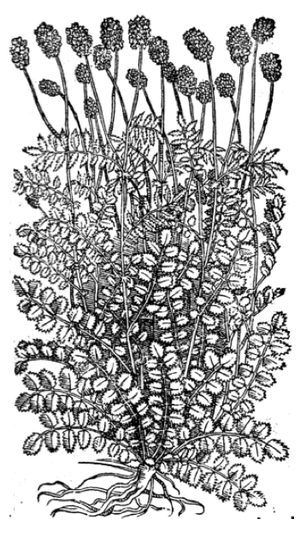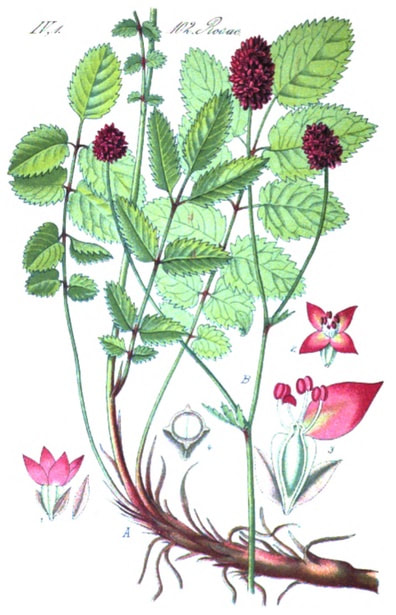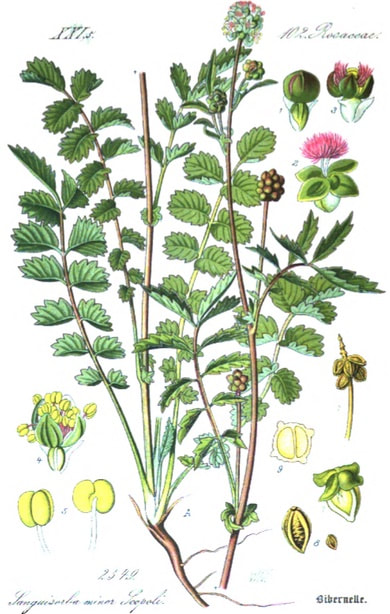Sanguisorba, Burnet, Di Yu 地榆
Di Yu (TCM)
Della Materia Medicinale, Andrea Valuassori, 1562
Botanical name:
Sanguisorba officinalis
Greater and Lesser types were known
Parts used:
Root
Temperature & Taste:
Slightly Cool, dry. Bitter, Sour. 'of a pleasant nature'.
Classifications:
2P. HEMOSTATIC
3C. ALEXIPHARMIC
TCM:
L. Stop Bleeding
Sanguisorba officinalis
Greater and Lesser types were known
Parts used:
Root
Temperature & Taste:
Slightly Cool, dry. Bitter, Sour. 'of a pleasant nature'.
Classifications:
2P. HEMOSTATIC
3C. ALEXIPHARMIC
TCM:
L. Stop Bleeding
Uses:
1. Cools the Blood, Stops Bleeding: (TCM, West)
-all types of Bleeding associated with Heat
2. Stops Leakages (TCM, West):
-Leukorrhea, Spermatorrhea
3. Clears Heat, Resists Poison (TCM, West):
4. Moves the Qi, Calms the Heart and Mind:
-‘quickens the Spirits, Refresh and Cheer the Heart, and Drive away Melancholy’ (Culpeper)
5. Clears Heat and Phlegm, Stops Cough:
-Coughs and Asthma.
6. Tonic:
-‘Continual use preserves the body in health and the Spirits [Qi] in vigor ... It is a friend to the Heart, Liver, and other principal parts of a Man’s body’ (Culpeper; Candied Root is a stronger tonic)
7. Externally:
-Sores, Wounds and Burns. It dries excess fluid and promotes the generation of new flesh.
Dose:
Decoction: 5–15 grams
Powder: 1–3 grams
Preparation:
... available in PRO version
Substitute:
... available in PRO version
Decoction: 5–15 grams
Powder: 1–3 grams
Preparation:
... available in PRO version
Substitute:
... available in PRO version
Main Combinations:
1. Diarrhea and Dysentery, Burnet with ... available in PRO version
2. Diarrhea or Dysentery with Blood in the stool:
i. Burnet with ... available in PRO version
ii. Burnet with ... available in PRO version
iii. Burnet with ... available in PRO version
iv. Burnet with ... available in PRO version
v. Burnet, ... available in PRO version
vi. Burnet, ... available in PRO version
3. Bleeding Intestinal Abscess, Burnet, ... available in PRO version
4. Excessive Menstruation, Uterine Bleeding:
i. Burnet, ... available in PRO version
ii. Burnet with ... available in PRO version
iii. Burnet, ... available in PRO version
iv. continuous, Burnet, ... available in PRO version
5. Coughing Blood, Burnet, ... available in PRO version
6. Nervous Heart disorders, combined Burnet with ... available in PRO version
7. Madness, Burnet with ... available in PRO version
8. Cancer:
i. Burnet ... available in PRO version
ii. Burnet ... available in PRO version
9. To preserve from Plague and Epidemic diseases, Burnet, ... available in PRO version
10. Topically to burns:
i. prepare a powder of Burnet and ... available in PRO version
ii. make a paste of Burnet, ... available in PRO version
Major Formulas:
Decoction for the Womb (Schroder)
Decoction of Parsley Compound
Syrup of Marshmallow (Fernel)
Syrup of Comfrey Compound
Electuary of Seeds
Cautions:
1. Not suitable for use in Cold bodies
2. 'In a case of dysentery complicated with general debility and cold or dysentery with watery and white discharge, it should not be used'. (Kou Zong Shi)
Main Preparations used:
Distilled Water of the whole Plant, Syrup of the Juice, Conserve of the Flowers
1. Not suitable for use in Cold bodies
2. 'In a case of dysentery complicated with general debility and cold or dysentery with watery and white discharge, it should not be used'. (Kou Zong Shi)
Main Preparations used:
Distilled Water of the whole Plant, Syrup of the Juice, Conserve of the Flowers





